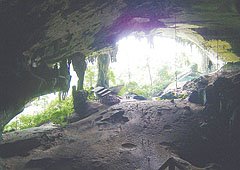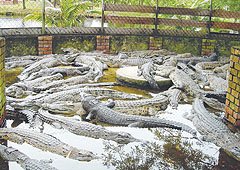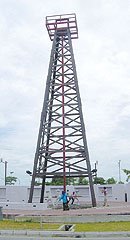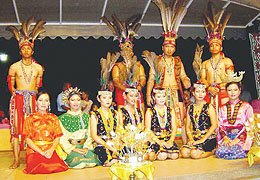By NYL
Miri is the third largest town in Sarawak, which is one of the two Malaysian states located on Borneo Island.
Miri shares a common border with Brunei and Indonesia and a greater part of it comprises the basin of Sarawak's second longest river, Sungei Baram and its many tributaries.
The petroleum industry has played a significant role in Miri's initial economic development. This is the town that oil built; subsequent industries such as timber and oil palm have also contributed to its prosperity today.
On May 20, 2005, Miri was declared a city.
Its location at a strategic part of Sarawak with the beautiful South China Sea's gentle breeze and crystal clear water that is ideal for diving is a bonus point for this city which already teems with visitors who come for shopping or just for a holiday.
Miri's wonderful cultural heritage is another great attraction as 19 ethnic groups offer colourful insights into their lives and traditions.
Visitors will not face any problem finding accommodation in Miri as the city has a wide range of hotels and inns catering to all types of tourists.
Dozens of restaurants, pubs and bars add colours to bustling Miri, which has a very compact and busy centre that is criss-crossed with numerous streets, all crammed with many rows of shops. Not to be missed are the street markets as well as some fine handicraft shops near the old harbour road along Jalan Bendahara.
Another hotspot is the daily native market located opposite the information centre and the main bus station. Here is where you can see, try and buy the many exotic jungle produces of Sarawak.
Being a city that owes its rapid growth to vast oil resources, it is quite natural that the most famous landmark is the "Grand Old Lady", the first well to strike oil in Sarawak back in 1910. Located on top of Canada Hill, this well was almost destroyed by a bush fire but now it is fully restored. Production has moved to offshore nowadays and some of the oil platforms can be seen from the top of Canada Hill, which also affords a panoramic view of Miri and the coast.
Along the Miri-Kuala Baram Road, some 20-minute drive from the city, is Miri's Crocodile Farm cum Mini Zoo. It is the first and largest crocodile farm in the northern region of Sarawak.
Enclosed within a 22 acre-landscaped setting are natural breeding and man-made sanctuary ponds specially carved out for the creatures. A stroll around its perimeter allows visitors to safely view an amazing collection of more than 1,000 crocodiles as well as numerous exotic animals from other countries.
Miri Public Park, along the Miri-Bintulu Road, is another popular place for visitors. It provides tourists an opportunity to conquer their fear of heights by walking on a swaying suspension bridge over a deep valley.
Look down from the bridge or lookout tower and you will enjoy a splendid view of the flower gardens and a children playhouse which resembles quaint assembled Lego-blocks.
When it comes to adventure, Miri has a lot of attractions. Gunung Mulu is just 40 minutes away by air and is the location of the world's largest cave system, the Mulu Caves, surrounded by pristine rainforests and the towering Mulu Mountain with its unique Pinnacle peak.
An important heritage site with prehistoric remains dating back 40,000 years is the Niah Caves, which is just a two-hour drive from the city. Another important national park is the Lambir Hills located a mere 25-minute drive from Miri.
It is the site of the world's most biologically diverse rainforest where numerous waterfalls cascade down rugged hill slopes. The park is said to contain 1,050 species of plants and 157 different types of birds.
Miri shares a common border with Brunei and Indonesia and a greater part of it comprises the basin of Sarawak's second longest river, Sungei Baram and its many tributaries.
The petroleum industry has played a significant role in Miri's initial economic development. This is the town that oil built; subsequent industries such as timber and oil palm have also contributed to its prosperity today.
On May 20, 2005, Miri was declared a city.
Its location at a strategic part of Sarawak with the beautiful South China Sea's gentle breeze and crystal clear water that is ideal for diving is a bonus point for this city which already teems with visitors who come for shopping or just for a holiday.
Miri's wonderful cultural heritage is another great attraction as 19 ethnic groups offer colourful insights into their lives and traditions.
Visitors will not face any problem finding accommodation in Miri as the city has a wide range of hotels and inns catering to all types of tourists.
Dozens of restaurants, pubs and bars add colours to bustling Miri, which has a very compact and busy centre that is criss-crossed with numerous streets, all crammed with many rows of shops. Not to be missed are the street markets as well as some fine handicraft shops near the old harbour road along Jalan Bendahara.
Another hotspot is the daily native market located opposite the information centre and the main bus station. Here is where you can see, try and buy the many exotic jungle produces of Sarawak.
Being a city that owes its rapid growth to vast oil resources, it is quite natural that the most famous landmark is the "Grand Old Lady", the first well to strike oil in Sarawak back in 1910. Located on top of Canada Hill, this well was almost destroyed by a bush fire but now it is fully restored. Production has moved to offshore nowadays and some of the oil platforms can be seen from the top of Canada Hill, which also affords a panoramic view of Miri and the coast.
Along the Miri-Kuala Baram Road, some 20-minute drive from the city, is Miri's Crocodile Farm cum Mini Zoo. It is the first and largest crocodile farm in the northern region of Sarawak.
Enclosed within a 22 acre-landscaped setting are natural breeding and man-made sanctuary ponds specially carved out for the creatures. A stroll around its perimeter allows visitors to safely view an amazing collection of more than 1,000 crocodiles as well as numerous exotic animals from other countries.
Miri Public Park, along the Miri-Bintulu Road, is another popular place for visitors. It provides tourists an opportunity to conquer their fear of heights by walking on a swaying suspension bridge over a deep valley.
Look down from the bridge or lookout tower and you will enjoy a splendid view of the flower gardens and a children playhouse which resembles quaint assembled Lego-blocks.
When it comes to adventure, Miri has a lot of attractions. Gunung Mulu is just 40 minutes away by air and is the location of the world's largest cave system, the Mulu Caves, surrounded by pristine rainforests and the towering Mulu Mountain with its unique Pinnacle peak.
An important heritage site with prehistoric remains dating back 40,000 years is the Niah Caves, which is just a two-hour drive from the city. Another important national park is the Lambir Hills located a mere 25-minute drive from Miri.
It is the site of the world's most biologically diverse rainforest where numerous waterfalls cascade down rugged hill slopes. The park is said to contain 1,050 species of plants and 157 different types of birds.
Courtesy of Borneo Bulletin





No comments:
Post a Comment